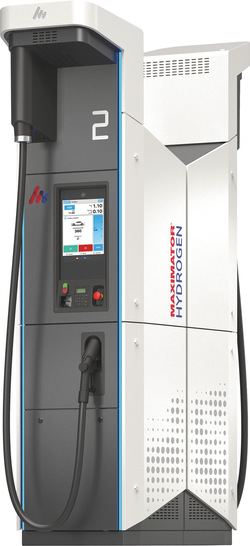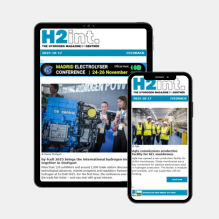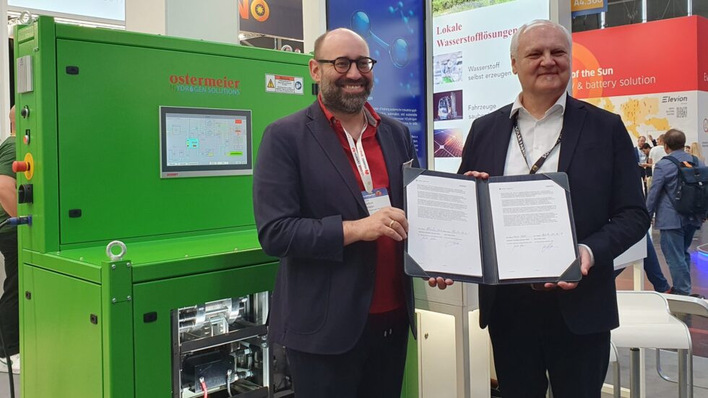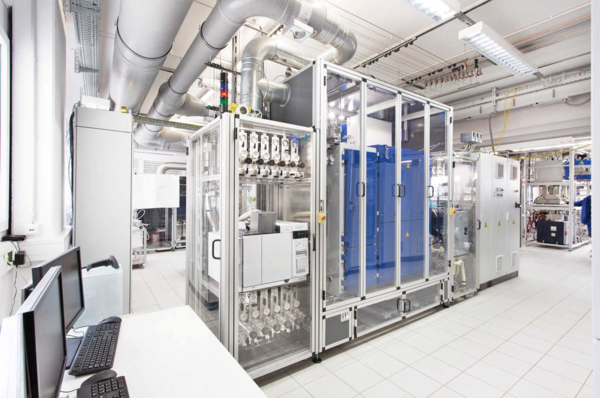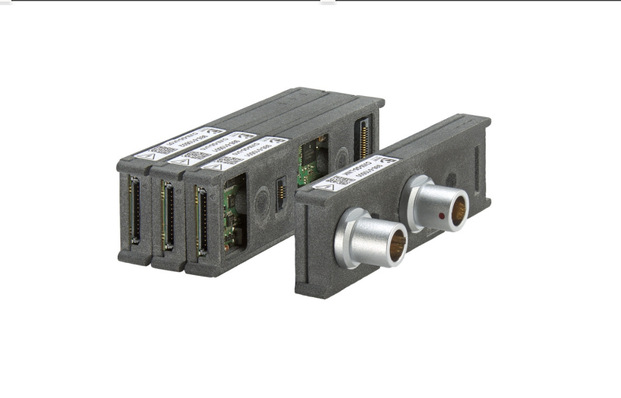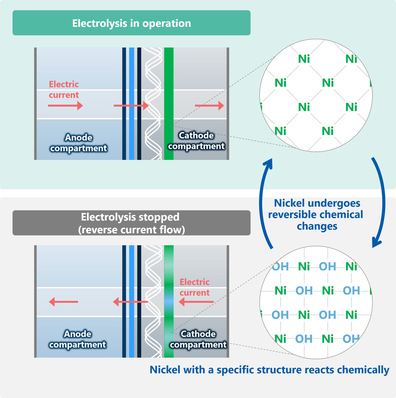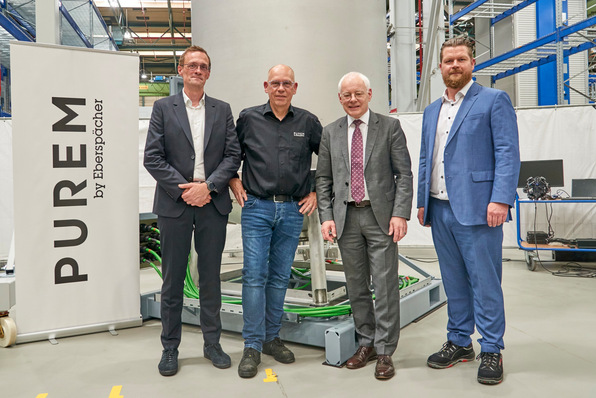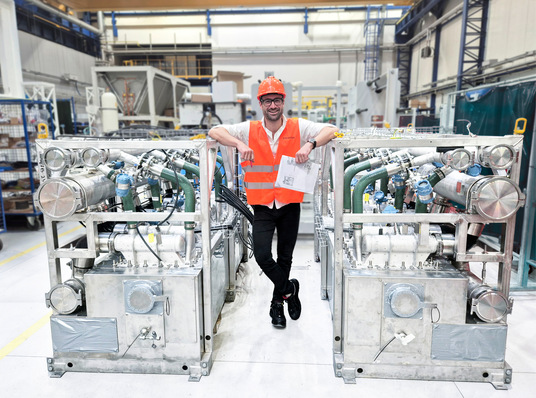Heavy-duty transport is one of the largest sources of CO2 emissions in the EU. Therefore, according to EU regulations, one third of all newly registered trucks must be equipped with electric drives or fuel cells by 2030. The EU regulation on the deployment of alternative fuels infrastructure (AFIR) stipulates that, starting in 2030, a hydrogen refueling station must be available every 200 kilometers along the Trans-European Transport Network (TEN-T). In addition, at every urban node, at least one publicly accessible hydrogen refueling station must be provided. So there is no shortage of plans. But in order to gain broad acceptance, hydrogen refueling must be just as user-friendly as conventional refueling with gasoline and diesel.
High pressures require expertise Most current fuel cell vehicles use high-pressure tanks with nominal operating pressures of 350 or 700 bar. Refueling vehicles with an explosive gas at such high storage pressures requires high safety standards.
To understand the challenges, it is important to consider some fundamentals of hydrogen refueling stations. The delivered hydrogen is stored in low-pressure H2 tanks. Using a compression system, the hydrogen is compressed to a specific pressure. The compressed hydrogen is stored in a high-pressure tank, from which it flows into the vehicle’s hydrogen tank at high speed due to the large pressure difference. At ambient temperature, hydrogen exhibits a negative Joule-Thomson effect. This means that, unlike most gases, it does not cool down when the pressure drops, but instead heats up. To prevent overheating, it is therefore cooled down to –40 °C before being dispensed into the fuel cell vehicle via a dispenser. “The challenge in hydrogen refueling is to precisely control the pressure while ensuring that the hydrogen temperature remains within a safe, predefined range. This is essential to ensure both efficiency and safety,” emphasizes Lukas Rainer.
A key regulation for fast and safe refueling is the SAE J2601 standard, defined by the American Society of Automotive Engineers (SAE). This standard specifies maximum values for the pressure during filling of the vehicle-side high-pressure tank and for the hydrogen temperature. Compliance with these parameters prevents thermal decomposition, deformation, and cracking of the storage material and is therefore essential for the safety of refueling operations.
Expansion of refueling stations Founded in 2019 and based in Nordhausen, Maximator Hydrogen aims to build more than 80 hydrogen refueling stations worldwide by the end of 2025. In Switzerland, 17 out of 18 hydrogen refueling stations come from Maximator Hydrogen. “Hydrogen can drive the mobility transition – and we are developing the infrastructure needed for that,” explains Lukas Rainer, who is responsible for the development of a new generation of dispensers at Maximator Hydrogen.
To develop its solutions, the company also draws on the knowledge and experience of Wika, the world’s leading provider of sensor solutions for pressure and temperature measurement technology. One example is the use of Wika’s high-pressure thermocouple TC90 in the Max Dispenser 1.5, a technically advanced “fueling column” for refueling hydrogen vehicles in accordance with the SAE J2601 refueling standard.
Temperature monitoring is a must According to SAE J2601, the temperature of the hydrogen at the beginning of the refueling process may fall below the minimum value of –40 °C. The maximum temperature for hydrogen vehicle tanks is +85 °C. Precise temperature monitoring prevents the tank from overheating and protects the system from damage that could theoretically lead to gas leakage. To prevent this, the system slows down the refueling process if the temperature becomes too high.
Temperature monitoring and control offer another advantage: “It allows us to optimize refueling performance,” explains Lukas Rainer. “As long as the hydrogen is cold enough, we can maintain a high filling speed.”
Accurate temperature data reduce costs for operators Temperature measurement also helps to precisely determine the “dead volume” in the hose, which is vented after refueling and thus lost. Since these losses must not be charged to the customer under any circumstances, the operator must calculate conservatively and absorb any inaccuracies. By knowing the pressure, temperature, and volume of the piping, it is possible to calculate exactly how much hydrogen was not transferred to the vehicle. This enables more accurate billing and prevents unnecessary additional costs for the operator of the hydrogen refueling station.
In the Max Dispenser 1.5, Wika’s high-pressure thermocouple TC90 monitors the temperature. A thermocouple consists of two different metal alloys joined at one point. Due to the thermoelectric effect, a voltage is generated that depends on the temperature. Thermocouples are used in hydrogen refueling stations because, compared to pt100 sensors, they are resistant to pressure and vibration and respond quickly to temperature changes.
To operate the components within the permissible specifications and, in the event of deviations, to first readjust the cooling in the dispenser and, if necessary, interrupt the hydrogen supply, the temperature is precisely monitored at two points. On the inlet side of the dispenser, the temperature of the incoming hydrogen is measured. On the outlet assembly of the dispenser, the filling temperature is redundantly monitored with two TC90 sensors to ensure that it remains between –40 °C and –17.5 °C in accordance with SAE J2601.
In addition, the temperature data from this measuring point are used to calculate the exact vented amount, as described above. The required DAkkS certification, which proves the calibration of the measuring device in compliance with legal metrology requirements, was obtained by Lukas Rainer for the TC90 from an external source.
High-pressure thermocouple TC90 “The Wika TC90 is a perfect fit for our requirements,” explains Lukas Rainer, who had already installed the thermocouple in the predecessor model of the MAX Dispenser 1.5. The fact that the TC90 thermocouple meets Maximator Hydrogen’s high requirements also convinced Maik Wenderott, Strategic Buyer at Maximator Hydrogen. “Three key factors spoke in favor of choosing the Wika TC90: its pressure resistance up to at least 1,034 bar, the short response time, and the ATEX certificate, which allows it to be used in potentially explosive atmospheres.”
Rainer and Wenderott describe the advantages more precisely as follows: The TC90 is compact and designed for measurement tasks in small nominal pipe diameters. The version with special high-pressure fitting gives the TC90 the necessary strength and ensures that the measuring point remains reliably sealed. The TC90 is so robust that no protective sheath is required. Its sensor tip withstands the pressures occurring in hydrogen refueling stations up to 1,034 bar even without protection. All wetted parts are made of H2-compatible materials. The direct contact of the sensor with the medium ensures short response times in the low-second range, enabling rapid readjustment of the cooling. In addition, there is the aforementioned ATEX certification.
Rainer also praises Wika’s customized solutions, such as a special sensor length. It was particularly important to Rainer that no adapter is required for the use of the thermocouple. This avoids additional potential leakage points.
As for the future of hydrogen mobility, Rainer is optimistic: “The industry is currently leaving the valley of death and entering a phase of steady growth.” In addition to regulatory requirements, the EU is currently providing € 422 million in funding for projects that promote refueling and charging infrastructure for alternative fuels – including 35 hydrogen refueling stations for trucks, buses, and passenger cars. Technological advancements are also contributing to the establishment of hydrogen technology. For example, operators of hydrogen refueling stations receive valuable data from Maximator Hydrogen to optimize their processes.
In terms of refueling time, hydrogen can already compete with diesel and gasoline thanks to modern dispensers and sensors. Before the coronavirus pandemic, the price was at least close to that of diesel. Rainer is confident: “In the medium term, hydrogen will compete with diesel and help make transportation emission-free.” 

© Wika


